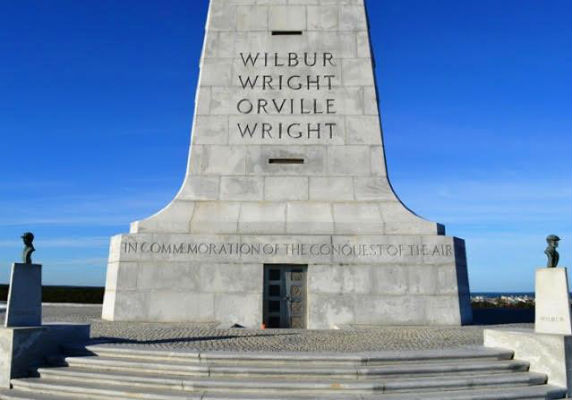Last updated: August 14, 2018
Lesson Plan
Location, Location, Location.

- Grade Level:
- Middle School: Sixth Grade through Eighth Grade
- Subject:
- Science
- Lesson Duration:
- 90 Minutes
- State Standards:
- EEn2.2.1 ~ Explain effects of human activity on shorelines, especially in development and artificial stabilization efforts.
Essential Question
Wilbur and Orville lived in Dayton, Ohio. Why did they choose Kitty Hawk, North Carolina for their experiments in flight?
Objective
The student will be able to:
- Identify the absolute location of the Wright Brothers National Memorial Monument
- Describe the relative location of the Wright Brothers National Memorial & why the wind and sand of the region were so important.
- Compare & contrast the relative & absolute locations of the first flight region of 1903 to the Wright Brothers National Memorial of today.
- Explain how humans have altered the barrier island in an an effort to stabilize & preserve the location.
Background
The Wright brothers needed an environment with steady winds of approximately 15 mph, minimal rain, a soft sandy place to land or crash and minimally populated in order to limit publicity. They studied the Weather Bureau records and chose the Outer Banks of North Carolina. Kitty Hawk, in particular, provided the sustained necessary winds, lots of sand for landing and very few people, meeting their ideal conditions. The location met all of their needs.
Preparation
Prior to visiting the Wright Brothers National Memorial, watch the following video of the Outer Banks.
https://www.youtube.com/watch?v=CSIPgdgiecw
Write your perception of what the Outer Banks/Kitty Hawk was like in 1903. What did it look like? What sounds might you have heard? What would it have smelled like? What might you have felt physically? Be specific and descriptive in your writing.
Materials
Compasses, Anemometers, Personal devices, and Pictures and maps of Kitty Hawk in 1903. To download the lesson materials list and full lesson plan, click the lesson materials link below.
Lesson Hook/Preview
Wilbur and Orville lived in Dayton, Ohio. Why did they choose Kitty Hawk, North Carolina for their experiments in flight?
Procedure
1. Explain how to use a compass and its importance in navigation. Point out similar tools on devices such as phones and computers. Demonstrate how latitude, longitude and elevation can be found using a personal device.
2. In groups of 3 or 4, hike to top of the Wright Brothers Monument to locate:
a.) North South East West using a compass
b.) latitude and longitude using device
c.) elevation using device
d.) sketch 2 maps of the Wright Brothers National Memorial using this information, one depicting what it might have looked like in 1903 and one as it looks today
3. Teach how to use an anemometer and why it is necessary to measure wind speed.
4. Measure the wind speed using an anemometer at the top of Big Kill Devil Hill and at the base of the Big Kill Devil Hill.
5. Record all of the above data and observations in the handout provided.
Vocabulary
Relative location - Relative location is the relationship of a place to other places.
Absolute location - A place's absolute location is its exact place on Earth, often given in terms of latitude and longitude.
Latitude - the angular distance of a place north or south of the earth's equator, or of a celestial object north or south of the celestial equator, usually expressed in degrees and minutes.
Longitude - the angular distance of a place east or west of the meridian at Greenwich, England, or west of the standard meridian of a celestial object, usually expressed in degrees and minutes.
Climate - the weather conditions prevailing in an area in general or over a long period.
Weather - the state of the atmosphere at a place and time as regards heat, dryness, sunshine, wind, rain, etc.
Barrier island - Barrier islands are coastal landforms and a type of dune system that are exceptionally flat or lumpy areas of sand that form by wave and tidal action parallel to the mainland coast. They usually occur in chains, consisting of anything from a few islands to more than a dozen.
Vegetation - plants considered collectively, especially those found in a particular area or habitat.
Assessment Materials
Post Visit:The Wright brothers chose Kitty Hawk for its ideal conditions; wind, sand and sparse population. Compare and contrast the Wright Brothers National Memorial region of 1903 to how it appears today. Prepare a Prezi to present. Be sure to cite credible sources.
(i.e.. .org, .gov, .edu, etc)
Site-Visit:
1. Sketch the Wright Brothers National Memorial and label N S E W.
2. Record the latitude and longitude of the monument.
3. Record the elevation of the monument at it’s base.
4. Sketch 1 (1903)
5. Sketch 2 (today)
6. Windspeed at top of the hill
7. Windspeed at bottom of the hill
8. Description of the topography (at least 6 to 8 sentences) You may use the back of the paper.
https://prezi.com/9wkutaolxkff/prezi-rubric/?webgl=0
https://prezi.com
Enrichment Activities
a.) Create a working anemometer out of household materials. Why was wind speed so important? Do they still need the same conditions today? Why or why not?
b.) Research the design of the Wright Brothers Monument and create an artistic rendition. Why was a star used in the design? What are other significant features of the design?
c.) Is Kitty Hawk still a secluded area? Why or why not? Would this still be a good area for Wilbur and Orville to test their experiments? Where would be a good place today to conduct their experiments? Why?
Additional Resources
Websites:
First Flight (Today in History)
http://memory.loc.gov/ammem/today/dec17.html
https://www.history.com/this-day-in-history/first-airplane-flies
Books:
Wind and Sand: The Story of the Wright Brothers at Kitty Hawk by Lynne Wescott and Paula Degen
